So this is going to be a little different from the two previous Carbonara Confessions. I didn’t go to any restaurants, I didn’t suffer through badly made carbonaras, laden with cream and/or ingredients that had no business being there. Enough discussion was had in the comments on the two posts, both here and in various social media outlets, that I thought I’d simply share how I make carbonara. Then, other than occasionally trying one at a restaurant hither, thither, and yon, we’ll just stick with homemade. It’s simple and quick to make, and more delicious than you might think, especially if you’re used to those bacon-cream sauces that purport to be the real thing.
Let’s start with our ingredients. I’m making a portion for one – I was solo for the evening, and it was just a moment to play in the kitchen. Adjust quantities based on how many are dining and whether it’s your main course or just an appetizer. For me, this was dinner.
On the right, of course, our pasta, typically made with a dry, long pasta. I happen to like fusilli, and so that’s what I used. On the left, some coarsely ground pepper (about 25 grinds of the mill, probably came out a little over a half teaspoon); two egg yolks; grated sheep’s milk pecorino cheese; grated parmigiano. In the middle, you (yes, you up there in San Isidro, just hang on a second) will note what looks like more than the usual, which should be either diced guanciale (cured pork cheek/jowl), or Italian style pancetta (which is rolled and cured, but not smoked, pork belly).
But, you may note that towards the back, there are a couple of pinches of herbs (rosemary and thyme) and a garlic clove. Why? Why, you might ask. Because… take a deep breath and relax… if I could have found either guanciale or real pancetta, I wouldn’t have those, but I just couldn’t find either of them. The best I could do was a very light smoked bacon. So why the garlic and herbs? Because guanciale and pancetta, traditionally, are cured in a rub of salt, sugar, garlic, rosemary, and thyme. So when you use one of those diced up, you get hints of those flavors, more or less built into the meat.
When I can’t get one of those, what I do is infuse a little of those flavors into the rendered fat of the bacon. It’s really a small amount, and if I’d have happened to have fresh of the two herbs, I’d have just stuck a sprig of each in the fat for a few minutes and then removed them. I didn’t, so I used a small pinch of each, dried. Consider those optional, and if you’re using real guanciale or pancetta, leave both herbs and garlic out of this whole process, the flavor’s already there in the meat.
Get your salted pasta water boiling, and drop the pasta into it. Also put your saute pan over medium heat. The timing on this works out really well, the “sauce” takes the same amount of time as cooking the pasta, pretty much perfectly. Once the pasta’s in the water, put the diced meat into the already hot pan and start browning it and rendering out the fat.
Once you’ve got a bit of fat rendered out, add in the garlic clove, just lightly crushed but still whole, and the pinch or sprigs of herbs.
Continue cooking until nicely browned and the fat is well rendered. Remove the garlic clove and herb sprigs (if you’re using pinches of dried, don’t worry about removing those, though I picked out some of the more obvious rosemary leaves), and discard them.
While the meat is browning and rendering, put the egg yolks, cheese(s), and pepper in a warm bowl (I just had this bowl sitting on the back of the stove, you don’t want it hot, but a bit warmer than room temp is good. You could set it briefly over the simmering pasta water, just a minute at the most.
Whisk this mixture together. You’re now basically ready for the final moments… as soon as the pasta is perfectly al dente….
Tip the meat and rendered fat into the egg mixture…
Add the pasta – I don’t drain it off, I just scoop it out, still dripping wet – this adds just a small amount of the pasta cooking water to the bowl at the same time as the noodles.
Immediately begin to toss it all together. Just from the heat of the pasta and meat, the cheese will melt, the yolks will thicken, the pasta water will help emulsify it all into a creamy texture. You can taste at this point for salt, but it’s highly unlikely you’ll need to add any – there’s already salt in the cheese, the cured meat, and the pasta water.
Because of the way it’s cooked, carbonara is one of those pastas that a) has to be cooked in the moment, and b) can’t really be reheated. If you put it over direct heat, or in the microwave, you’re going to curdle the eggs, and that will ruin the texture of the sauce. I find myself wondering if that, perhaps, was the original impetus behind people adding cream to the sauce – to prevent the egg from curdling when heated up, allowing you to make the sauce in advance and just warm it up and ladle it over pasta. And, at some point, it just got carried away and the cream began to predominate rather than just be enough to keep the eggs from curdling?
And serve. Eat. Enjoy. I swear to you this is far better than pasta in the typical bacon cream sauce that folks in the US and UK seem to think is carbonara. Really, I swear it.
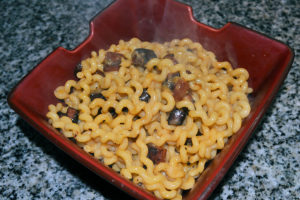
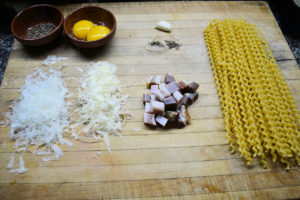
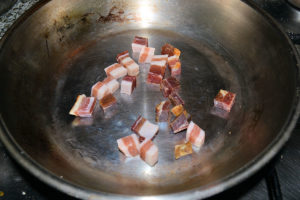
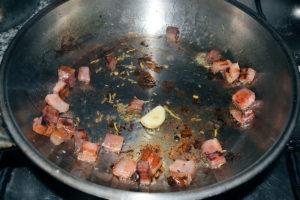
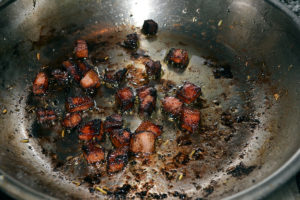
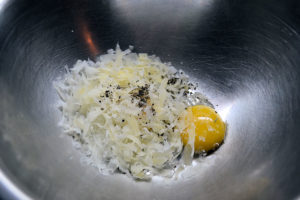
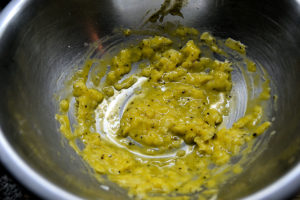
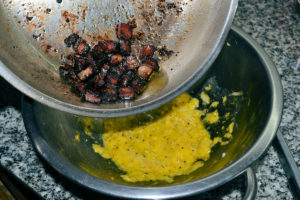
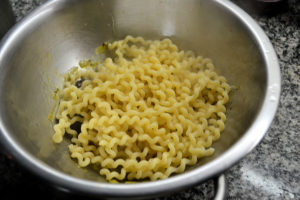
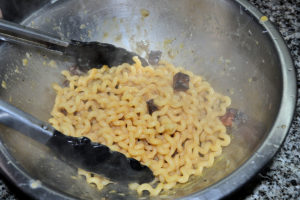
Hello Dan. I made this for dinner tonight – it’s great, and much better than having stuff swimming in cream. I might’ve overcooked the pancetta, but who doesn’t like crispy bits? It certainly put the ‘carbon’ in ‘carbonara’.
Some people actually prefer the pancetta nice and crispy – I kind of like it sort of half crispy half soft. Glad you liked this version! Got a photo?
I’m kicking myself – I did think about taking a photo, but we were hungry and it was going down too quickly. Hand on heart, it looked quite like yours, so I was chuffed.
I’m devastated. But made up for by the fact that you ate it all and liked it! 😉
[…] Edit: This “series” continues with a demo of how I personally make a reasonably classic carbonara. […]